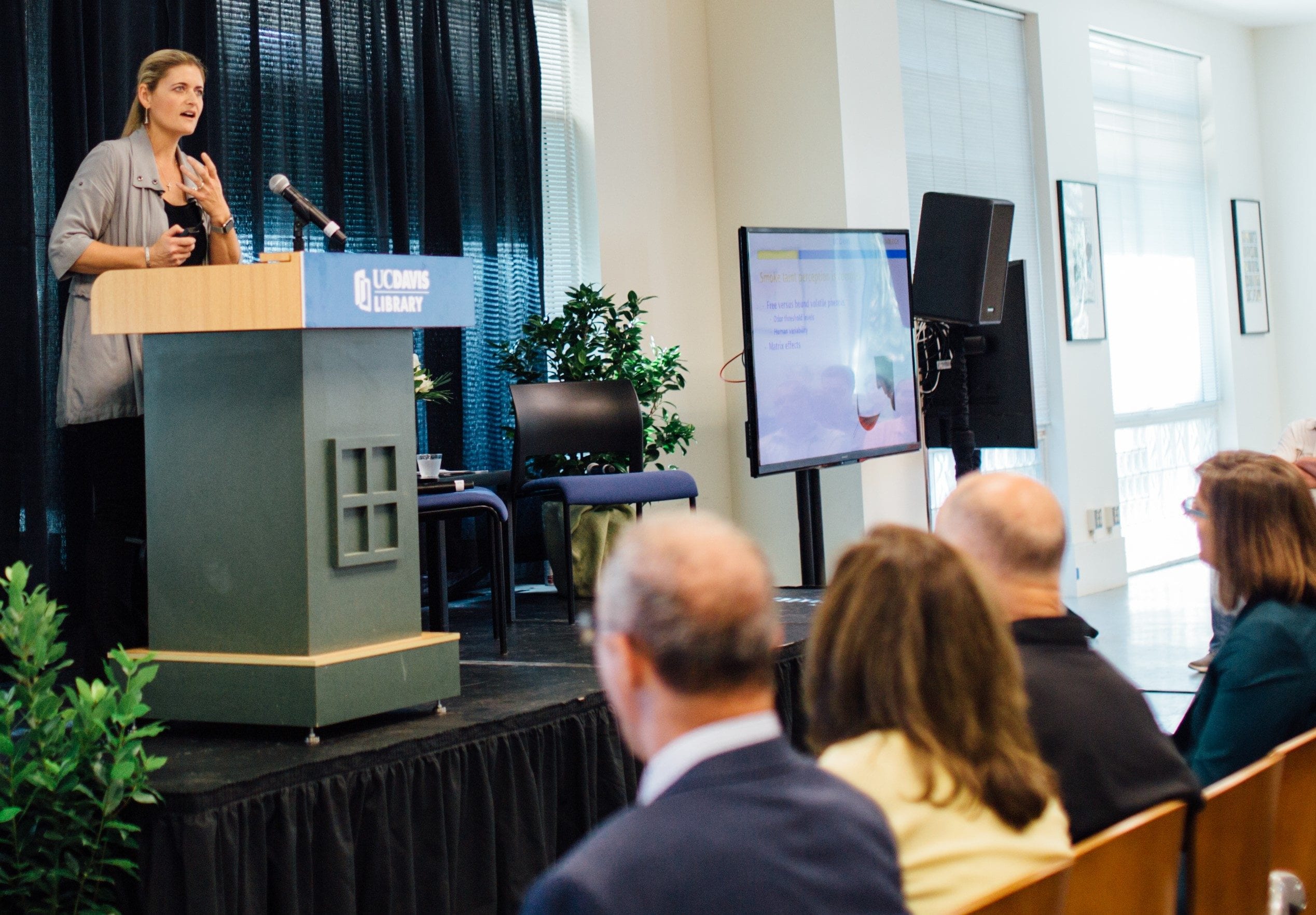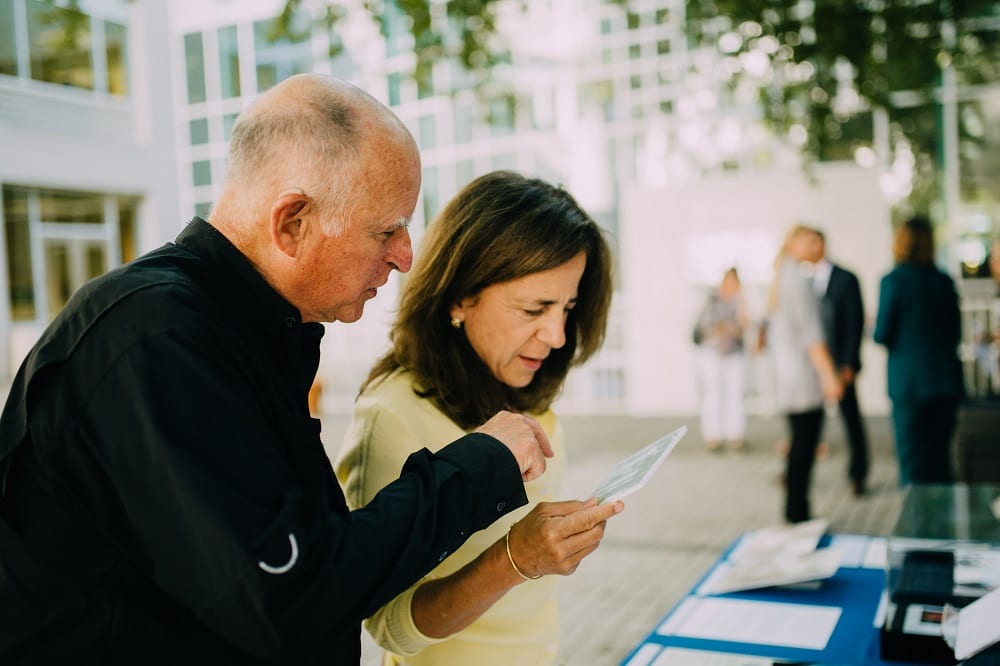Jerry Brown speaks about climate change on June 3, 2019 at Shields Library. (Photo credit: Alana Joldersma)
Lecture Highlights the Impact of Climate-Driven Wildfire on California Wine
Driven by climate change, catastrophic wildfires may be the new normal in California. Seven of the 20 deadliest and most destructive fires in the state’s history have been in the last five years. 600,000 acres — five percent of the state — have burned. Yet the implications for agriculture, including the state’s $35 billion wine industry, are just beginning to be understood.
Since the 2017 Napa and Sonoma fires, UC Davis enologist Anita Oberholster has been one of the researchers on the front lines analyzing the effects of smoke exposure on wine grapes. Last week, she shared the stage with former Governor Jerry Brown — who has consistently been among California’s most clear-eyed and articulate leaders calling for action on climate change — for a joint lecture on Wine, Wildfire and Climate Change, the second in a new series on food and wine cosponsored by the Robert Mondavi Institute and the UC Davis Library.
“Too much of a good thing”

A wine taint, Oberholster explained, is any outside influence “that overpowers a wine, making it one-dimensional, so that it only has one characteristic. In the case of smoke taint, that overpowering characteristic is smoky, burnt, campfire, medicinal, earthy. And you also have this lingering retro-nasal character at the back of your throat that people describe as ‘licking a cold ashtray.’”
The culprit is volatile phenols, which are released when wood burns — and easily absorbed by grapes and wine. Ironically, these same compounds, in other contexts and far smaller doses, are highly desirable in winemaking. In fact, the process of toasting a wine barrel chars the inside of the barrel and creates the same compounds, just at a much lower level.
“At a low level, it adds complexity to your wine,” Oberholster said. “At a high level, too much of a good thing is not a good thing anymore. It overpowers the wine and causes a taint.”
An accidental experiment bears fruit
Oberholster was running an entirely different experiment at UC Davis’ Oakville Station vineyard when wildfires suddenly swept through Napa County just before the harvest in October 2017. She quickly recognized the opportunity — and the importance for the industry — of refocusing her study on smoke taint in order to contribute to California winemakers’ understanding of the phenomenon; up until then, virtually all of the data was from Australia. With a batch of grapes she had fortuitously harvested before the fires began as a control group, she set out to test the level of smoke taint in the resulting wine and potential techniques for ameliorating the taint.
“An unpredictable period that we know is not good”
Former Governor Jerry Brown put the issue in a broader context. For all the investment required to understand smoke taint and its impact on the multi-billion dollar wine industry, he noted, “that’s just one tiny little part of the climate change problem.”
“When we think about tasting smoke in your wine, it’s pretty complex. Climate change is millions of times more complex than that,” Brown said. “But we have to figure it out, because this is not about shifting from wine to beer. This is about human existence.”
Citing a December 2018 article from Nature, Brown warned that “global warming will happen faster than we think,” and will bring with it significant harm — exposing more than 1.5 billion people to deadly heat extremes and hundreds of millions more to vector-borne diseases like malaria. He also noted the unpredictable and non-linear nature of climate change, and that seemingly unrelated factors can accelerate global warming in unexpected ways.
A wake-up call

While noting California’s leadership — to tighten green building standards, incentivize zero-emissions vehicles, establish a cap-and-trade program, and set targets for increasing renewable energy generation — Brown also emphasized the need to do more.
“We have to somehow wake up our own communities, wake up the world,” he said. “It’s going to take a shift in thinking, a shift in awareness. This is not just a technological challenge. It’s that for sure; it’s a scientific challenge. But it’s also a human challenge.”
The four-term governor, who was first elected in 1975, recalled:
When I was governor the first time, there were 300 million cars in the world. Now there are a billion. At the rate we’re going, there will be a second billion pretty soon. The future cannot be the same. It’s going to have to be different. And that difference is going to be created by technology, by scientific breakthroughs, but also by people [changing] the way they live… We can’t keep going the way we are now.
As Brown describes it, California’s wine industry is facing a local problem — smoke taint due to wildfire — with a global solution: stopping climate change. And it is a solution in which every one of us has a role.
“You do have power”
Toward the end of the Q&A, after thanking Brown for his leadership, junior Alana Joldersma asked how he would respond to the perspective she often hears from peers that “I am just one person. This one little thing I do won’t make a difference.”
Brown responded by saying that “in order for the political leaders to make the changes needed, there is going to have to be a lot more change in the society itself.” Because political leaders look at what their constituents want, “your personal change and transformation are helping.” He concluded:
If it’s only you, no, we’re done. But you, and you, and you, first by the thousands, the millions, the hundreds of millions, billions, that changes things. And yes, it takes the president. But it also takes ordinary people. The civil rights movement did not start with a senator or a president. The women’s rights movement, the gay rights movement, the environmental movement did not start with political leaders. They started with other people changing consciousness. That’s why I say transformation is the key element.
You do have power. You’ve got to exercise it, and your enthusiasm will spread to other people. Because the people at the top — they’re listening. And you are part of the message they need to pick up.